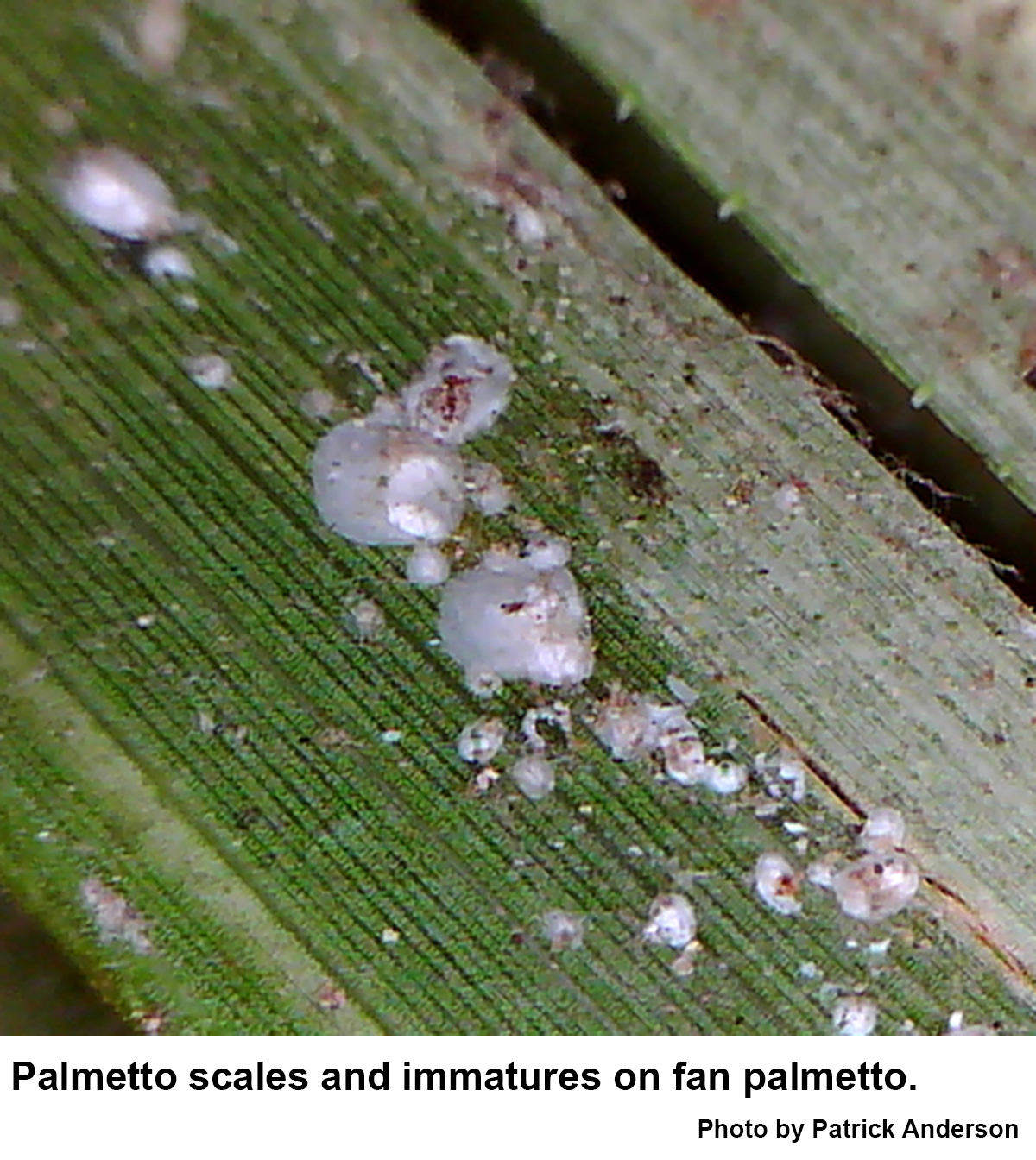Description and Biology
Palmetto scale, Comstockiella sabalis, is one of the armored scale insects. Females are pink to reddish and more or less round in top view. The armor is white and it has a slightly off center first instar cast skin that is usually white to yellow. Females have circular armor, and males have slightly smaller and more elongate armor. Females lay at least eight cream to pink eggs under their armor. Males are tiny, pale, winged insects with four eyes but no mouthparts. They emerge from under their armor and try to find and mate with a female before dying a short time later.
Host Plants
Although the palmetto scale may occur on palms, it is not particularly damaging as long as its parasites are present. Apparently its saliva is not acutely toxic. On the other hand, the scale is probably not really helping its host plant either. When palmetto scale was accidently introduced to Bermuda, it caused severe damage and death to many Bermuda palmettos. But when parasites were then introduced, the palmetto scale population dropped to acceptable levels. Cabbage or sabal palm, coconut palm, dwarf palmetto, Mexican blue palm, Mexican fan palm, San Jose hesper palm, and saw palmetto are all hosts of the palmetto scale insect.
Residential Recommendation
Palmetto scales are susceptible to horticultural oils. It would be well to use not more than the 2% rate to prevent damage to the fronds. The plant should be well irrigated before treatment and kept out of direct sunlight until the pesticide residue evaporates to prevent damage.
References
- Armored Scale Identification and Management on Ornamental Plants. Frank, S. 2022 (revised). Entomology Insect Notes, NC State Extension Publications.
- Common name: palmetto scale, scientific name: Comstockiella sabalis Comstock (Insecta: Hemiptera: Diaspididae). Espinosa, A., A.Hodges and G. Hodges. 2009 (update 2012). Featured Creatures, Entomology & Nematology, FDACS/DPI, EDIS Pub. No. EENY-465
- Horticultural Oils for Ornamental Plants. Steven Frank, S., J. R. Baker, S. Bambara. 2018. Entomology Insect Notes, NC State Extension Publications.
- Extension Plant Pathology Publications and Factsheets
- Horticultural Science Publications
- North Carolina Agricultural Chemicals Manual
For assistance with a specific problem, contact your local N.C. Cooperative Extension Center.
This Factsheet has not been peer reviewed.
Publication date: May 15, 2014
Reviewed/Revised: March 23, 2024
Recommendations for the use of agricultural chemicals are included in this publication as a convenience to the reader. The use of brand names and any mention or listing of commercial products or services in this publication does not imply endorsement by NC State University or N.C. A&T State University nor discrimination against similar products or services not mentioned. Individuals who use agricultural chemicals are responsible for ensuring that the intended use complies with current regulations and conforms to the product label. Be sure to obtain current information about usage regulations and examine a current product label before applying any chemical. For assistance, contact your local N.C. Cooperative Extension county center.
N.C. Cooperative Extension prohibits discrimination and harassment regardless of age, color, disability, family and marital status, gender identity, national origin, political beliefs, race, religion, sex (including pregnancy), sexual orientation and veteran status.

